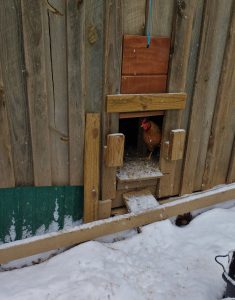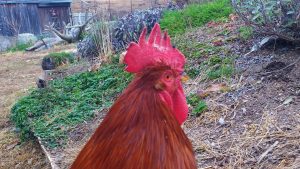There are four articles in this series on different strategies for cold-weather chicken care. This article explores how to prevent and treat frostbite in chickens. To read the others, click on the links below:
- “Cold-Weather Chicken Care: 11 Quick Ideas to Improve Chicken Comfort”
- “The 13 Best Chicken Breeds for Cold Climates”
- “How to Keep Chicken Water From Freezing”
___________________________
Frostbite isn’t normally something I worry about in my holler here in Surry County, North Carolina. However, this past winter, with record-breaking cold temperatures lasting for weeks at a time, I learned a few lessons about how to prevent and treat frostbite in chickens.
It all started when Rasputin, my rebel rooster, refused to use good sense and get out of the cold. As our temperatures dropped into the single digits and 40 mph wind gusts sent the rest of the flock running for shelter, Rasputin planted his feet firmly—in a few inches of frozen-over snow—and held his ground.
I don’t know if it was the wind that made him crazy, or if the idea of being stuck in a coop with 22 unhappy hens kept him from the coop. But, even as his comb began to swell, then turned white at the tips, and his feet flushed red … he stood tall.
More from the Homestead Guru: Grow Food Year Round in a $300 Underground Greenhouse(Opens in a new browser tab)
Now, Rasputin happens to love being held and cuddled. So I repeatedly picked him up, gave him a warming snuggle and took him to one of our many straw-laden sheltered areas. Yet each time I went back out to deliver warm water to my flock, I would find him out in the cold. Again.
So, here’s lesson No. 1 in how to prevent frostbite in chickens:
Lesson 1: If your chickens don’t have the good sense to get out of the cold (and stay there), lock them up!
Our coops keep predators out, but they can also be used to keep chickens in. They might not like it. But for their own safety, don’t hesitate to keep your chickens in the coop during extreme cold.

Now, I have to confess, I wasn’t really thinking about the frostbite when I carried Rasputin back to the coop. I was concerned about how much feed he would eat if he burned all his calories out in the cold. He’s a big rooster, with a big appetite, and I like to keep my feed costs low. Also, I had a few other hens out in the yard—namely my Buckeyes and my Salmon Faverolles—showing no signs of cold whatsoever.

It was only later, when I noticed that some white spots on Rasputin’s comb started fading to black and shriveling up, that I realized what had happened. Now, Rasputin is descended from a rescued fighting rooster, so he is very heavy and tall and has a few circulatory problems. His comb is more susceptible to episodes of ringworm than the combs of my other chickens. So, even though the timing was odd, I thought those white spots were just a little ringworm recurrence.
More from the Homestead Guru: 5 DIY Chicken Coop Designs That Wont Leave You Broke!(Opens in a new browser tab)
Discovering that I’d missed the early signs of frostbite in my big boy helped teach me these next two lessons:
Lesson 2: Comb size matters. Pay extra attention to your roosters with large combs and wattles and to any chickens with standard combs.
My cold-hardy breeds like the Buckeyes and the Salmon Favorelles have small combs that sit tight on their heads. In cold weather, your chicken’s body will preserve heat by cutting blood flow to the comb. This puts chickens with larger combs at greater risk because large combs are more exposed to the elements.
Many people who keep chickens in cold climates swear by slathering petroleum jelly on larger combs and wattles to help prevent frostbite, and some talk about lanolin as a more eco-friendly alternative. Keep in mind that humidity, even more than cold, is a factor in causing frostbite, so make sure you have proper ventilation (but no drafts) in your coop to keep the humidity level as low as possible.
More from the Homestead Guru: How To Grow Survivor Tomatoes(Opens in a new browser tab)
Now, even cold-hardy breeds, with cold-suited combs, can be subject to frostbite on their feet. Which brings me to my next lesson:
Lesson 3: Know how to identify the early signs of frostbite and take action sooner rather than later.
Early frostbite looks a whole lot like a minor case of ringworm. Patches of pale white appear on the affected areas on the comb and wattles. As the frostbite continues, the areas start to darken and spread. If the area becomes solid black, it then begins to dehydrate and look a bit like crispy bacon (though not nearly as appetizing).

On the feet, frostbite shows up as splotches of red. They tend to be most prominent between the toes, but the splotches also show up on the legs. Some cases may result in swelling and blistering.
Severe frostbite can also impact behavior. Frostbitten chickens can become lethargic and disinterested in normal activity, and can lose their appetites.
Once you know what to look for, then you need to be prepared to act if necessary.
Treating Early Frostbite
If you see the early signs of frostbite while they are happening, take your chicken to a warm place and slowly bring affected areas up to temperature. For example, have your chicken stand in a warm foot bath (around 100ºF) and gently press a warm wash cloth around the comb area. Do not rub either of these areas as that will likely be painful for your chicken.
Once your chicken is sufficiently warm, give them time to dry before returning them to their coop.
More from the Homestead Guru: Cold Weather Chicken Care: 11 Quick Ideas to Improve Chicken Comfort(Opens in a new browser tab)
Treating More Severe Frostbite
If your chicken is showing signs of lethargy and loss of appetite as a result of frostbite, this is likely a more serious case. Keep your chicken confined to a warm area and monitor their affected areas and behavior for a couple of days before returning them to their coop.
If they develop more severe symptoms like blistering or continued loss of appetite, infection may be a concern. At that point you will want to refer to your chicken health manual for details on how to treat infection and when to enlist the help of a veterinarian.
The one I use and recommend is The Chicken Health Handbook by Gail Damerow.
What Happens After a Chicken Suffers Frostbite?
In Rasputin’s case, he recovered quite quickly from his frostbite. He never faced infection and always had his appetite. However, the most affected areas on his comb are in the process of sloughing off as the damaged skin dries and withers. A little while from now, he may lose some of the tips of his once-stately rooster comb. He probably won’t notice this loss most of the time. However, in hot weather, his reduced comb area may impact his ability to cool himself quickly. So, I’ll need to give him a little more attention in hot weather now, too.

In case impending cold weather has made you consider cold-hardy breeds for your coop, check out the next article in our Cold-Weather Chicken Care series, which highlights 13 cold-hardy breeds to consider for your spring purchase.
Or, for emergency cold-weather care ideas, check out our article on improving chicken comfort in winter.




